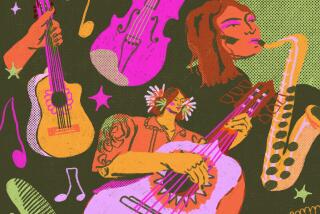The Sounds of Science : Stretching the Definition of the Term Musical Instrument
- Share via
When Adolphe Sax, perhaps the most prolific instrument maker who ever lived, created the saxophone and dozens of other inventions in France in the mid-19th Century, he was vilified by jealous competitors and conservative musicians with an extraordinary fury. Band members refused to play his unconventional instruments, he was maligned in the press, a suspicious fire damaged his factory, he was even physically attacked. Though his instruments gradually gained acceptance in his lifetime, Sax was hounded by lawsuits challenging his patents, and he died penniless.
The world has since become more receptive to musical innovations. Today, musicians, especially in Southern California, are making and using instruments that didn’t exist a few years ago. Some are bizarre; some are the product of state-of-the-art computer technology. Many are already being put to use in the motion picture and recording industries. In fact, you may already have heard a few, even if you haven’t heard of them.
Craig Huxley, for instance, created his Blaster Beam 10 years ago and has played it most recently on sound tracks for “Knots Landing” and all the “Star Trek” movies. His invention is impressive even when it isn’t making a sound: a hollow aluminum beam that can range from two to 21 feet long with 24 bronze wires strung taut along one face. Huxley plays it through an amplifier, usually with mallets or an empty artillery shell casing that he slides along the wires. The sound it produces is otherworldly: deep, reverberating metallic chords--like God playing a cello strung with high-voltage wires.
In Huxley’s Burbank recording studio sits another remarkable instrument. Though not of his invention, it is one that you also may have heard. The Synclavier is the highest of high tech, a Rolls-Royce of electronic musical instruments, and with a price tag of $45,000 to $200,000, depending on the extras, it’s about as expensive. The Synclavier isn’t much to look at--a keyboard and control panel, plus a desk-top computer--but it is a virtual orchestra in itself.
Through a 5-year-old technology called digital sampling, the Synclavier can analyze, or “sample,” the waves produced by any sound--a violin, an oboe, a gong, a footstep, a sneeze--up to 100,000 times per second. Then it stores the information in its memory and assigns it to a particular key on its keyboard. The precise sound can then be recalled at will. The Synclavier can also change the pitch of each sound by altering its frequency. If striking one key produces the sampled sound of middle C on a grand piano, the key to the right can be programmed to make the same sound in D. A musician, then, can essentially “play” any instrument, from a cowbell to a clarinet, whose sounds have been encoded in the Synclavier’s software. Or he can play a dog’s bark, a baby’s cry, the wind, a jet engine’s whine or the Mormon Tabernacle Choir up and down the scale. What’s more, he can combine several sounds--say, a trumpet, violins and the cooing of a dove--to custom-design a sound never heard before. And if that doesn’t suit him, the Synclavier can draw a three-dimensional picture of each sound on its computer screen so that a composer can alter as many as 24 physical characteristics of each note, including pitch, vibrato, intensity and sustained length. Like a musical word processor, the Synclavier can also move notes from one part of a score to another, change a note without having it replayed, synchronize sound with videotape, even print out a newly improvised song in precise musical notation.
The Synclavier is only the most lavish example of new instruments spawned by the microprocessor revolution. With the advent of digital recording (the process used with compact discs, in which the characteristics of sound waves are translated into a code of numbers), electronic musical instruments are now able to speak a common language with computers and with one another. The result is profoundly affecting how music is made and is stretching the definition of the term musical instrument .
Many of the inventions shown here, for example, don’t make sounds themselves but are new ways of controlling synthesizers, other than with a keyboard. An “instrument” today is likely to be several pieces of equipment--a couple of synthesizers, a sampler, a Macintosh computer--combined to produce the sound that a musician is looking for. And the ability of music machines to create unique, hybrid sounds has further blurred definitions. Says Roger Bourland, an assistant professor in the music department at UCLA: “Any time you create a new sound on a synthesizer, in a sense--in the old sense--you’ve created a new instrument.”
Technology has opened up a universe of sounds to composers and musicians, with obvious advantages. The computer is ending the drudgery of transcribing songs into musical notation, splicing magnetic tape and re-recording to correct mistakes. As the technology becomes cheaper and more available, music making is becoming more democratic. “What used to be available only to rich rock stars 10 or 15 years ago is now accessible to kids,” says Craig Anderton, editor of Electronic Musician magazine.
And sound can be manipulated in strange ways. In the 1984 movie “Starman,” for example, much of the “string section” on the sound track wasn’t violins and violas--it was the hum of mosquitoes in a jar, layered through a Synclavier, say musicians Brian Banks and Anthony Marinelli. To create an atmosphere for a song on his recent album, Thomas Dolby used the digitally sampled sound of chirping cicadas in Mexico as a background beat, a tree falling in the jungle in place of a bass drum and wind blown across a partially filled milk bottle instead of a flute.
But there are some drawbacks. The technology that puts an orchestra at one musician’s fingertips also puts a lot of people out of work. “It’s a touchy subject,” says Peter Otto, manager of electronic studios at California Institute of the Arts. “It’s an incredibly exciting time, especially for composers, computer people, keyboard people. It’s a scary time for people who have been making their living in the studios because they’re being replaced.”
Until recently, another limitation has been the shape of the synthesizers themselves. No matter how faithfully a microprocessor can reproduce a digitally sampled oboe or violin, many of the subtle, expressive nuances of those instruments simply can’t be duplicated on a keyboard. So the latest innovations have focused on ways for traditional instruments to talk directly to a computer. Already, flutes, guitars, violins and grand pianos have been retrofitted with interfaces for synthesizers. All of which has led to a curious side effect: In the new age of electronics, guitars can sound like violins, flutes like trumpets, keyboards like drums.
Where musical instruments will go from here is anyone’s guess. At a 1985 music symposium in Amsterdam, performer Michel Waisvisz introduced a device called “the Hands,” which makes the usual idea of an “instrument” all but obsolete. He strapped his hands to two thin boards, connected by wires to a synthesizer; when he waved his hands in the air, the apparatus sensed their relative position in space and made sounds accordingly. By operating switches on the devices, Waisvisz controlled the sounds that the synthesizer made.
One day performing musicians may even be obsolete. A team of Japanese researchers has designed a $2-million, vaguely humanoid robot that can play the organ. It sight-reads music with its camera / head, then plays everything from Bach chorales to Barry Manilow with its arms, fingers and feet. It even understands and speaks a limited vocabulary, so it can take requests from the audience.
Though the computer revolution in music has been under way for several years, it may be a while before a group of computer programmers can sell out a concert at the Sports Arena. For one thing, Otto says, “computing as a spectator sport has some pretty serious limitations. I think that the computer itself as an object is going to be changing. What we’re going to be seeing is instruments with microprocessors in them and traditional sorts of instruments with a few wires hanging out of them, which are then talking to computers.”
Nyle Steiner has been working on such an invention for 12 years. His EVI (for Electronic Valve Instrument) looks, he says, “like a bug sprayer.” It uses fingering like that of a trumpet and has a mouthpiece that can convey, among other things, subtle changes in air pressure to a synthesizer. He says he has built several hundred of them in the dark, cluttered back room of his La Crescenta house. Not long ago, Barbra Streisand introduced Steiner and his EVI to the nation on her HBO special. “It’s not highly known yet,” Steiner says, “but it’s highly heard. Almost every TV series has used it at one time or another. Any person on the street has probably heard it at least once.” He recently sold the rights to the EVI to the Japanese company Akai, which hopes to mass-produce it soon.
Many of the new musical instruments featured here may never be heard by more than a few of their creators’ closest friends. But others--like, perhaps, Steiner’s EVI--could one day become as much a part of music as Adolphe Sax’s most famous invention.
More to Read
The biggest entertainment stories
Get our big stories about Hollywood, film, television, music, arts, culture and more right in your inbox as soon as they publish.
You may occasionally receive promotional content from the Los Angeles Times.










